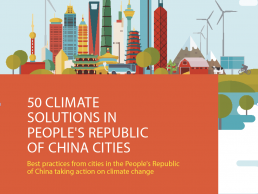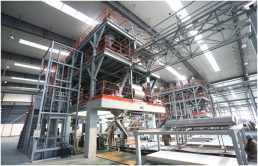First appeared in

Asian Development Bank
50 climate solutions from cities in the People's Republic of China
To promote better lifecycle utilization and reduce industrialwaste, this project uses industrial solid waste to replacecement in the production of a new type of low-carbon building board for prefabricated buildings.
Since 2014, a local company has been producing building boards for prefabricated buildings from solid waste, with an annual production capacity of 22 million m2 in its Weihai factory. In 2016, the factory used about 800,000 tons of solid waste, replacing cement and sandstone to produce building boards totaling 3.76 million m2. Up to 70% of waste materials, including paper, styrofoams, and glass, are used to create the new construction materials, which are then processed to form the frameworks and parts for new buildings, leaving only 20% of the construction work to be completed on site. Compared with traditional raw materials for building boards, this initiative saved about 18,000 tons of cement in 2016.
65.6M
TONS OF INDUSTRIAL WASTE CAN BE RECYCLED WHEN THE PROJECT IS RUNNING AT FULL CAPACITY.
The technology is being developed further, enabling the building boards to be 3D printed at the factory. This will allow 90% of the construction work to take place at the factory. The materials are constructed to be able to withstand earthquakes with a magnitude of 9.0 and are also water and fireproof.

The factory in Weihai is substituting the greenhouse gas-intensive building materials, cement, and sandstone with waste (photo by Jieshi Zhang).
The Challenge
Steel and cement production in the PRC contribute almost 20% of the country’s carbon emissions. In Weihai, a new facility is replacing cement in building materials by putting some of the city’s 6 million tons of solid industrial waste to use, reducing the amount sent to landfill and improving soil, air, and water pollution.
Co-Benefits
Economic The project used 80,000 tons of waste in 2016, saving approximately 18,000 tons of cement for producing building boards. This resulted in significant savings for purchasing or producing cement.
Environment This project reduces environmental pollution caused by disposal and storage of solid waste, and could also reduce NOx, SO2, and dust emissions caused by cement production.
Social When the full production capacity of the project is realized, it will provide 2,000 jobs for local residents.

